Lallart M. Ferroelectrics: Characterization and Modeling
Подождите немного. Документ загружается.

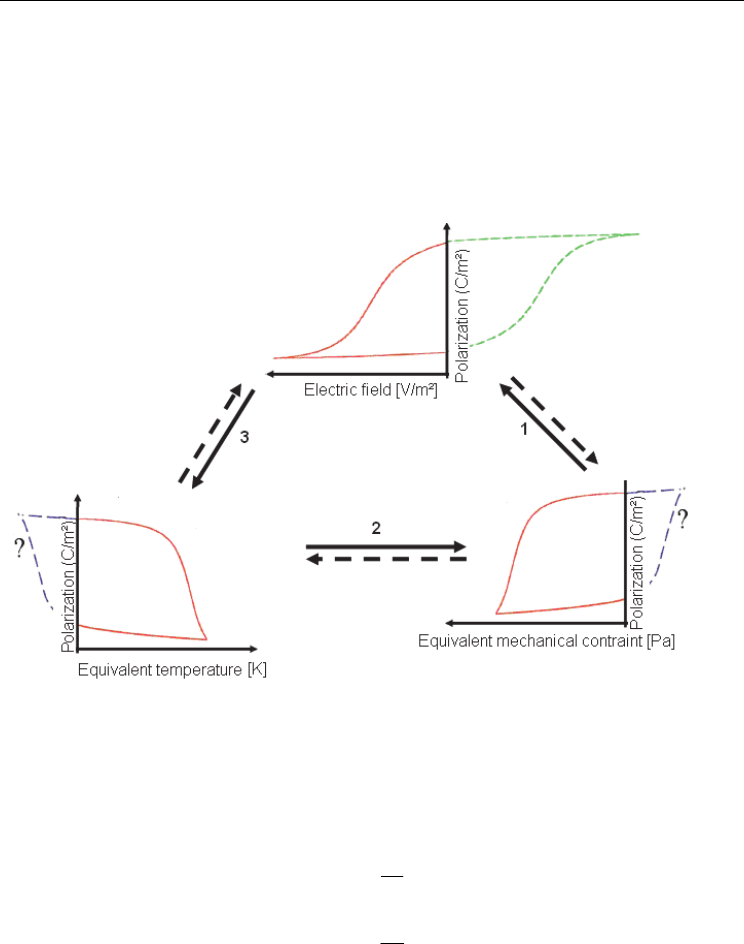
Nonlinearity and Scaling Behavior in a Ferroelectric Materials
509
different conditions (stress, electrical field, and temperature).It would thus be interesting to
predict their behaviors under a variety of excitations without having to perform too much
experimental work, i.e., just carrying out a single experiment and providing the other
experimental values. For example, from a simple measurement of the polarization as a
function of the electric field, one could predict the behavior of the polarization as a function
of temperature negative and positive(step 2) and stress (compressive and tensile stress) (step
1). In conclusion, we could determine P(T) and P(θ) from P(E) (steps 1 and 3),P(E) and P(θ)
from P(T) (steps 1 and 2), and finally P(E) and P(T) from P(θ) (steps 2 and 3),.
Fig. 13. Schematic illustration of the material behavior under excitations.
6. Relationship between the coefficients d
33
and ε
33
The proposed scaling law can also be applied to the minor cycles. This fact provides a great
advantage for the problem of the relation between
33
ε
and
33
d according to
33
P
E
ε
∂
=
∂
(2)
33
P
d
T
∂
=
∂
(3)
It is quite difficult to experimentally obtain a real d33 corresponding to an exact
ɛ
33
. During
the experiment, the electrical field (E) was stopped at a certain level to obtain a value of the
polarization (P), and the permittivity (
ɛ
33
) could thus be defined. When E was stopped, d
33
was calculated based on the obtained
33
and did consequently not correspond to thereal d
33
.
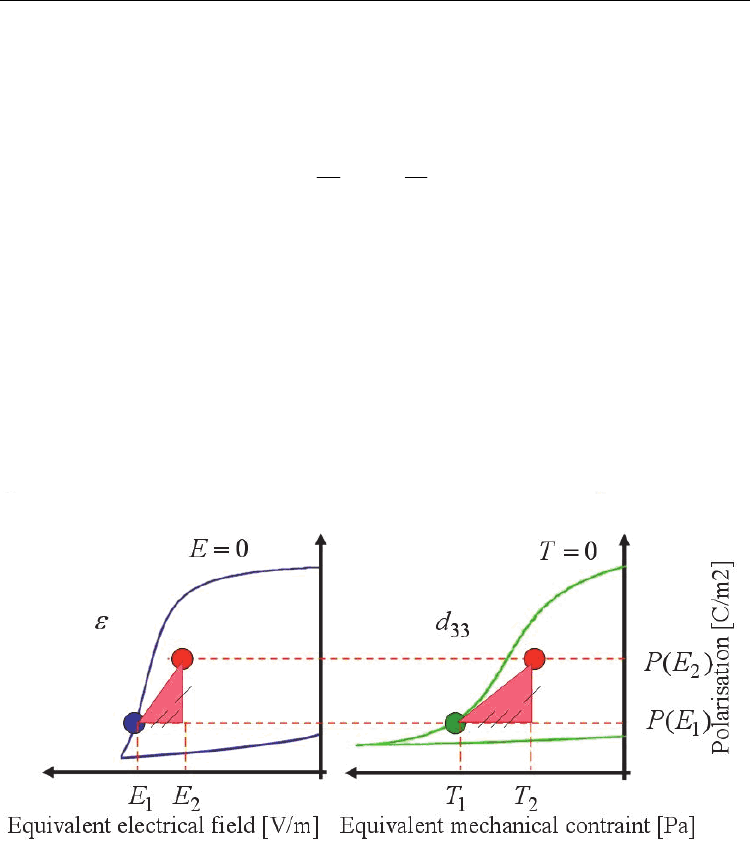
Ferroelectrics - Characterization and Modeling
510
As illustrated in Fig. 14, the measuring point for P was not on the main cycle but slightly
beside, on the minor cycle. This result was due to the difference of E
0
+ΔE from ɛ, not
corresponding to that of T
0
+ΔT from d
33
. Resultantly, the calculation of d
33
could not be
based on an exact value. By using the proposed simple scaling law, on the other hand, it was
possible to obtain an exact value for d
33
,
()
PP
hP
TE
∂∂
=−
∂∂
(4)
thus,
33 33
()dhPP
ε
=− . (5)
Figure 15 depicts the prediction of the piezoelectric constant (d
33
) under a compressive
stress. In this case, d
33
was calculated from the function h[P(E,T=0)] and compared with
experimental values. It could be observed that the experimental and calculated piezoelectric
constants displayed a similar variation with the compressive stress. Such a good agreement
between simulation and experiment proved that the proposed law scaling rendered it
possible to predict the piezoelectric constant (d
33
) under stress using only purely electrical
measurements. Reciprocally, predictions of the dielectric constant (
ɛ
33
) under an electrical
field were permitted using only purely mechanical measurements.
Fig. 14. relation between ε
33
et d
33
7. Conclusion
The present chapter proposes a three simple scaling laws taking into account the electrical
field, the stress, temperature, and the polarization of ferroelectric materials in the form of
0
(, )ETPET
α
Δ≡Δ× ,
0
(2 ( , )).EPE
β
θθ
Δ≡ × Δ and T
δθ
Δ≡×Δ. The nonlinear behavior was
considered and compared to that predicted by a linear reversible constitutive law in order to
demonstrate the range of validity of the linear assumptions.
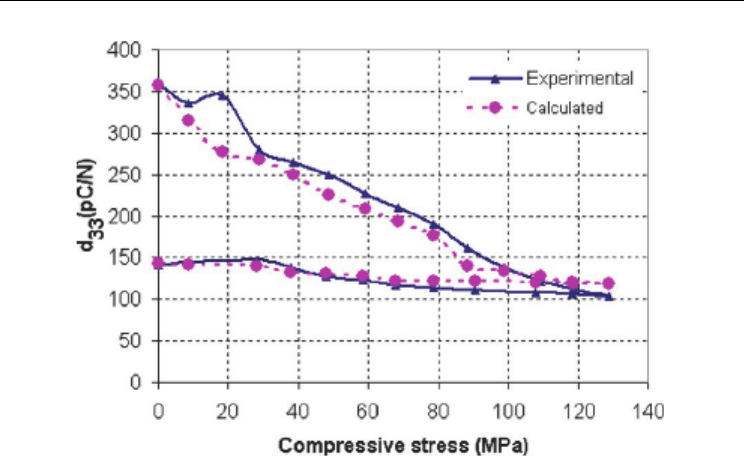
Nonlinearity and Scaling Behavior in a Ferroelectric Materials
511
Fig. 15. (Color online) Evolution of the piezoelectric coefficient under compressive stress
The proposed scaling laws can be used for several models have been proposed in the
literature for comprehending the hysteretic behavior of various materials, which renders it
interesting to interpret the results as a function of the combined to two or three excitations
(mechanical stress and temperature for example).The ease of conversion between P(E), P(θ)
and P(T) cycles by such a simple laws gives numerous opportunities regarding the use of
piezoelectric materials. It was possible to predict the depoling behavior over the entire stress
cycle (compressive or tensile), or to predict the depoling behavior over the entire
temperature cycle (negative or positive) from to the hysteresis cycle. Thus, one should note
that applying a symmetric electrical field cycle leads to a dissymmetric cycle under stress
and temperature. Consequently, the polarization behaves differently as a function of
compressive as opposed to tensile stresses. Moreover, the polarization behaves also
differently as a function of positive and negative temperature.
8. References
[1] L. E. Cross, Ferroelectrics 76,241 (1987).
[2] G. H. Haertling, J. Am. Ceram. Soc. 82, 797 (1999).
[3] S. E. Park and T. R. Shrout, IEEE Trans. Ultrason. Ferroelectr. Freq.
[4] B. Jaffe, W. R. Cook, and H. Jaffe, Piezoelectric Ceramics Academic, London, (1971)
[5] C. Bedoya, C. H. Muller, J.-L. Baudour, V. Madigou, M. Anne, and M. Roubin, Mater. Sci.
Eng., B 75,43 (2000).
[6] E. C. Subbarao, M. C. McQuarrie, and W. R. Buessem, J. Appl. Phys. 28, 1194 (1957).
[7] A. Hajjaji, S. Pruvost, G. Sebald, L. Lebrun, D. Guyomar, and K. Benkhouja, Solid State
Sci. 10, 1020 (2008).
[8] S. Pruvost, G. Sebald, L. Lebrun, D. Guyomar, and L. Severat, Acta Mater. 56, 215 (2008).

Ferroelectrics - Characterization and Modeling
512
[9] vA. E. Glazounov and M. J. Hoffmann, J. Eur. Ceram. Soc. 21, 1417 (2001).
[10] D. Berlincourt, H. Helmut, and H. A. Krueger, J. Appl. Phys. 30, 1804 (1959).
[11] A. Hajjaji, S. Pruvost, G. Sebald, L. Lebrun, D. Guyomar, and K. Benkhouja, Acta Mater.
57, 2243 (2009).
[12] S. C. Hwang, J. E. Huber, R. M. McMeeking, and N. A. Fleck, J. Appl. Phys. 84, 1530
(1998).
[13] T. Steinkopff, J. Eur. Ceram. Soc. 19,1247 (1999).
[14] B. Ducharne, D. Guyomar, and G. Sebald, J. Phys. D 40,551 (2007).
[15] A Hajjaji, S Pruvost, G Sebald, L Lebrun, D Guyomar, K Benkhouja, Acta Mater. 57
(2009) 2243.
[16] A. Hajjaji, D. Guyomar, S. Pruvost, S. Touhtouh, K. Yuse, and Y. Boughaleb, Physica B
(2010).
[17] G. H. Haertling, J. Am. Ceram. Soc. 82, 797 (1999).
[18] S.-E. Park and T. R. Shrout, IEEE Trans. Ultrason. Ferroelectr. Freq. Control 44, 1140
(1997).
[19] S. C. Hwang, J. E. Huber, R. M. McMeeking, and N. A. Fleck, J. Appl.Phys. 84, 1530
(1998).
[20] T. Steinkopff, J. Eur. Ceram. Soc. 19,1247 (1999).
[21] B. Ducharne, D. Guyomar, and G. Sebald, J. Phys. D: Appl. Phys. 40,551 (2007).
[22] G. Sebald, S. Pruvost, L. Seveyrat, L. Lebrun, and D. Guyomar, J. Eur. Ceram. Soc. 27,
4021 (2007).

0
Harmonic Generation in Nanoscale
Ferroelectric Films
Jeffrey F. Webb
Swinburne University of Technology, Sarawak Campus
Malaysia
1. Introduction
The presence of surfaces or interfaces causes the behavior of ferroelectric materials to
differ from that of the bulk, in a way analogous to that for magnetic and superconducting
materials(Tilley, 1993; 1996). Here we will be concerned with a theoretical model that takes
into account the influence of surfaces on a ferroelectric film. There is also experimental
evidence that indicates that size effects in ferroelectrics are observable (Gerbaux & Hadni,
1989; Gerbaux et al., 1989; Höchli & Rohrer, 1982; Kulkarni et al., 1988; Marquardt & Gleiter,
1982; Mishina et al., 2003; Scott & Araujo, 1989) ;more recently, the strong influence of
boundaries on ferroelectric behaviour has been demonstrated (Li et al., 1996; 1997).Due to
the advent of ferroelectric random access memories (Scott, 1998) size effects in ferroelectric
thin films are of increasing importance.
This chapter shows how the Landau-Devonshire theory of ferroelectrics can be applied to thin
films and how the dynamic response to incident electromagnetic radiation can be calculated.
One aim is to show how harmonic generation components that occur because of the nonlinear
response of the ferroelectric can found and in particular how they are reflected from the film.
This is done because it relates to reflection measurements that could be carried out on the film
to investigate the theoretical proposals experimentally. Since ferroelectrics are responsive in
the terahertz region, terahertz wave measurements, especially in the far infrared region would
be the most relevant. Another aim is to present a general theory that serves as a foundation
for other calculations involving ferroelectric films.
To begin with, the Landau-Devonshire theory for calculating the static polarization is
developed starting with a bulk ferroelectric and progressing from a semi-infinite film to one
of finite thickness. It is then shown how dynamical equations can be incorporated together
with a Maxwell wave equation in order to calculate the dynamic response. This in general
is a nonlinear problem and using a standard perturbation expansion technique it is shown
how the harmonic components can be isolated and calculated. Finally a specific example of
second harmonic generation for a ferroelectric film on a metal substrate is given in which the
reflection coefficient is calculated exactly under simplified boundary conditions.
2. Landau-Devonshire theory
The starting point of the Landau-Devonshire theory is the Gibbs free energy expressed as
a series expansion in powers of components of the polarization vector P. The equilibrium
26

2 Will-be-set-by-IN-TECH
polarization is found from the minimum of the free energy function; the temperature
dependence is such that below the Curie temperature the minimum corresponds to a non-zero
polarization but above this temperature it is zero, thus representing one of the basic properties
of a ferroelectric. Also the property that the spontaneous polarization can be reversed by the
application of an external electric field is manifest in the theory by more than one minimum in
the free energy so that the polarization can be switched between different possible equilibrium
polarizations. We will need a free energy expression for a ferroelectric film. Here we
first develop the ideas for a bulk ferroelectric and a semi-infinite ferroelectric as this is an
instructive way to lead up to the thin film case.
2.1 Bulk ferroelectrics
For a bulk ferroelectric a Gibbs free energy of the following form is often used (Lines & Glass,
1977)
F
=
1
2
AP
2
+
1
4
BP
4
+
1
6
CP
6
, (1)
where
A
= a(T − T
C0
) (2)
and
P
2
= P
2
x
+ P
2
y
+ P
2
z
. (3)
The equilibrium polarization for the bulk ferroelectric is given by the minimum of the free
energy, found by solving
∂F
∂P
= 0 → AP
B
+ BP
3
B
+ CP
5
B
= 0. (4)
For first order transitions, which are discontinuous, B
< 0 and C > 0. But for second order
transitions, where the magnitude of the polarization changes continuously from P
B
to zero as
the temperature is raised through T
C0
, the term in P
6
can be dropped (C = 0) and B > 0. a is
always a positive constant. The theory is phenomenological so that the parameters described
take values that can be found from experiment, or which, in some cases, can be calculated
using first-principles methods based on microscopic models of ferroelectrics (Iniguez et al.,
2001).
Figure 1 illustrates the behaviour for the second-order case C
= 0; for T > T
C0
the minimum
of F is at P
= 0, corresponding to no spontaneous polarization above T
C0
, the paraelectric
phase; and for T
< T
C0
minima occur at P = ±P
B
, where
P
B
=
|
A|
B
. (5)
This represents the switchable spontaneous polarization that occurs in the ferroelectric phase.
The free energy in Landau theory is invariant under the symmetry transformations of the
symmetry group of the paraelectric phase. The expression in Equation (1) is therefore, in
general, only an approximation to the actual free energy. For example, for a cubic ferroelectric
such as barium titanate, the paraelectric phase has cubic symmetry and the terms P
4
x
+ P
4
y
+ P
4
z
and P
2
x
P
2
y
+ P
2
y
P
2
z
+ P
2
z
P
2
x
are separately invariant and would need to be included in the free
energy. However, as brought out by Strukov & Lenanyuk (1998), for the simplest transition of
514
Ferroelectrics - Characterization and Modeling
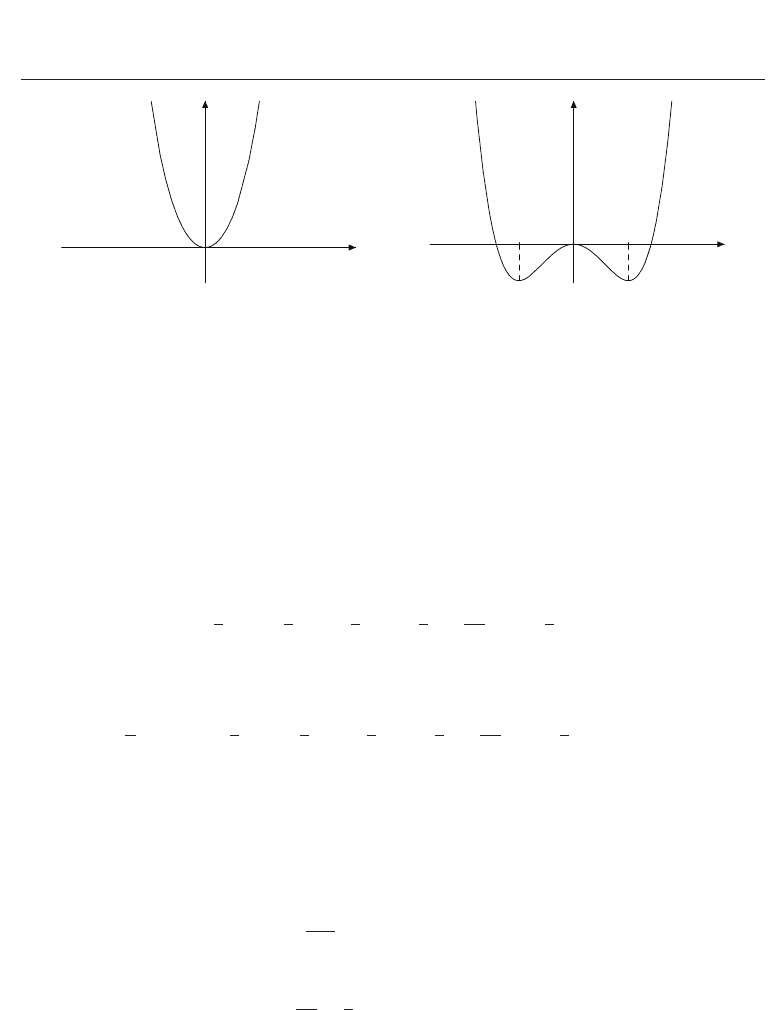
Harmonic Generation in Nanoscale
Ferroelectric Films 3
F
P
T
> T
C
F
P
−P
0
P
0
T < T
C
Fig. 1. Landau Free energy above and below T
C0
.
a perovskite ferroelectric from its cubic paraelectric phase to a tetragonal ferroelectric phase
Equation (1) has appropriate symmetry.
2.2 A semi-infinite film
We take the film surface to be in the xy plane of a Cartesian coordinate system, and assume
that the spontaneous polarization is in-plane so that depolarization effects (Tilley, 1996) do
not need to be taken into account. The spontaneous polarization due to the influence of the
surface, unlike in the bulk, may not be constant when the surface is approached. Hence we
now have P
= P(z), and this implies that a term in |dP/dz|
2
is present in the free energy
expansion together with a surface term (Chandra & Littlewood, 2007; Cottam et al., 1984),
and the free energy becomes
F
=
dxdy
∞
0
dz
1
2
AP
2
+
1
4
BP
4
+
1
6
CP
6
+
1
2
D
dP
dz
2
+
1
2
D
dx dy P
2
(0)δ
−1
, (6)
so that the free energy per unit area where S is the surface area of the film is
F
S
=
∞
0
dz
1
2
AP
2
+
1
4
BP
4
+
1
6
CP
6
+
1
2
D
dP
dz
2
+
1
2
DP
2
(0)δ
−1
. (7)
The surface term includes a length δ which will appear in a boundary condition required
when the free energy is minimized to find the equilibrium polarization. In fact, finding
the minimum, due to the integral over the free energy expansion, is now the problem of
minimizing a functional. The well know Euler-Lagrange technique can be used which results
in the following differential equation
D
d
2
P
dz
2
− AP − BP
3
−CP
5
, (8)
with boundary condition
dP
dz
−
1
δ
P
= 0, at z = 0. (9)
The solution of the Euler-Lagrange equation with this boundary condition gives the
equilibrium polarization P
0
(z). It can be seen from Equation (9) that δ is an extrapolation
length and that for δ
< 0 the polarization increases at the surface and for δ > 0 it decreases at
the surface, as is illustrated in Figure 2.
515
Harmonic Generation in Nanoscale Ferroelectric Films
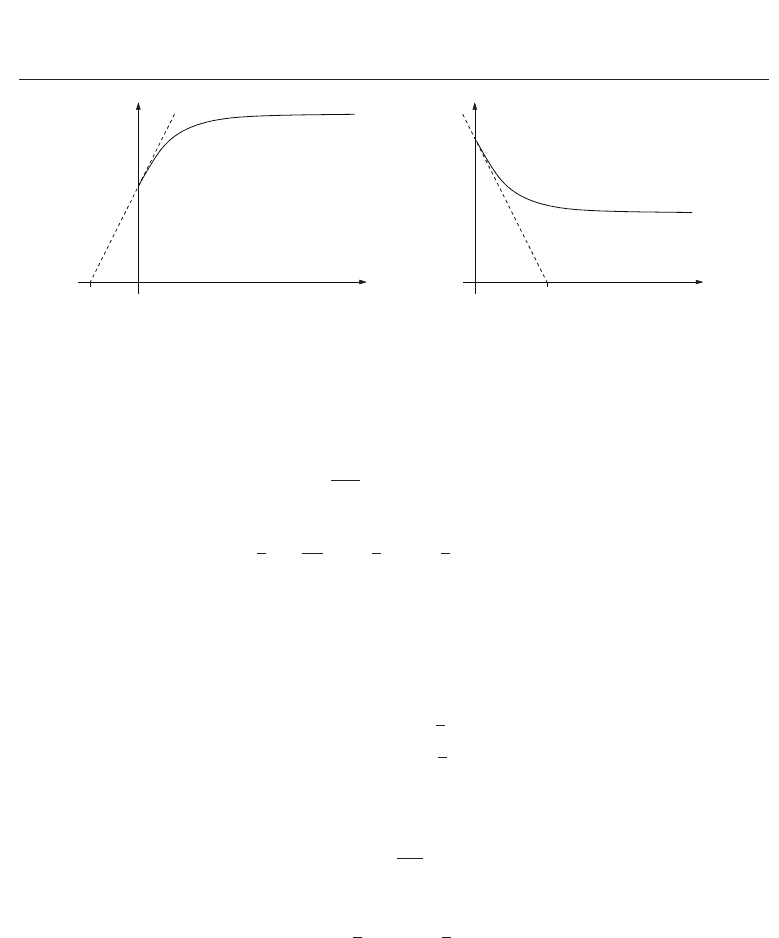
4 Will-be-set-by-IN-TECH
P
0
(z)
δ
δ
< 0
z
P
0
(z)
δ
δ
> 0
z
Fig. 2. Extrapolation length δ. For δ < 0 the polarization increases at the surface and for δ > 0
it decreases at the surface. The dotted lines have slopes given by
[dP
0
/dz]
z=0
.
For first order transitions with C
= 0 the solution to Equation (9) must be obtained
numerically (Gerbaux & Hadni, 1990). However for second order transitions (C
= 0) an
analytical solution can be found as will now be outlined. The equation to solve in this case,
subject to Equation (9), is
D
d
2
P
dz
2
− AP − BP
3
. (10)
The first integral is
1
2
D
dP
dz
2
−
1
2
AP
2
−
1
4
BP
4
= G, (11)
and since as z
→ ∞, P tends to its bulk value P
B
while dP/dz → 0,
G
=(1/2)AP
2
bulk
−(1/4)BP
4
bulk
. (12)
For T
< T
C0
, we take P
bulk
= P
B
, where P
B
is given by Equation (5) and G = A
2
/4B.
Following Cottam et al. (1984), integration of Equation (11) then gives
P
0
(z)=P
B
coth[(z + z
0
)/
√
2ξ], for δ < 0, (13)
P
0
(z)=P
B
tanh[(z + z
0
)/
√
2ξ], for δ > 0, (14)
where ξ is a coherence length given by
ξ
2
=
D
|A|
. (15)
Application of the boundary condition, Equation (9), gives
z
0
=(ξ
√
2 sinh
−1
(
√
2|δ|/ξ). (16)
Plots of Equations (13) and (14) are given by Cottam et al. (1984).
For the δ
< 0 case in which the polarization increases at the surface it can be shown (Cottam
et al., 1984; Tilley, 1996), as would be expected, that the phase transition at the surface occurs
at a higher temperature than the bulk; there is a surface state in the temperature range T
C0
<
T < T
C
. For δ > 0, the polarization turns down at the surface and it is expected that the
critical temperature T
C
at which the film ceases to become ferroelectric is lower than T
C0
,as
has been brought out by Tilley (1996) and Cottam et al. (1984).
516
Ferroelectrics - Characterization and Modeling

Harmonic Generation in Nanoscale
Ferroelectric Films 5
2.3 A finite thickness film
Next a finite film is considered. The thickness can be on the nanoscale, where it is expected
that the size effects would be more pronounced. The theory is also suitable for thicker films;
then it is more likely that in the film the polarization will reach its bulk value.
The free energy per unit area of a film normal to the z axis of thickness L, and with in-plane
polarization again assumed, can be expressed as
F
S
=
0
−L
dz
1
2
AP
2
+
1
4
BP
4
+
1
6
CP
6
+
1
2
D
dP
dz
2
+
1
2
D
P
2
(−L)δ
−1
1
+ P
2
(0)δ
−1
2
, (17)
which is an extension of the free energy expression in Equation (7) to include the extra
surface. Two different extrapolation lengths are introduced since the interfaces at z
=
−
L and z = 0 might be different—in the example below in Section 5.2 one interface is
air-ferroelectric, the other ferroelectric-metal. The Euler-Lagrange equation for finding the
equilibrium polarization is still given by Equation (8) and the boundary conditions are
dP
dz
−
1
δ
1
P = 0, at z = −L, (18)
dP
dz
+
1
δ
2
P = 0, at z = 0. (19)
With the boundary conditions written in this way it follows that if δ
1
, δ
2
< 0 the polarization
turns up at the surfaces and for δ
1
, δ
2
> 0, it turns down. When the signs of δ
1
and δ
2
differ, at
one surface the polarization will turn up; at the other it will turn down.
Solution of the Euler-Lagrange equation subject to Equations (18) and (19) has to be done
numerically(Gerbaux & Hadni, 1990; Tan et al., 2000) for first order transitions. Second order
transitions where C
= 0, as for the semi-infinite case, can be found analytically, this time
in terms of elliptic functions (Chew et al., 2001; Tilley & Zeks, 1984; Webb, 2006). Again the
first integral is given by Equation (11). But now the second integral is carried out from one
boundary to the point at which
(dP/dz)=0, and then on to the next boundary, and, as will be
shown below, G is no longer given by Equation (12) . The elliptic function solutions that result
are different according to the signs of the extrapolation lengths. There are four permutations
of the signs and we propose that the critical temperature, based on the previous results for the
semi-infinite film, will obey the following:
δ
1
, δ
2
> 0 ⇒ T
C
< T
C0
(P increases at both surfaces), (20)
δ
1
, δ
2
< 0 ⇒ T
C
< T
C0
(P decreases at both surfaces), (21)
δ
1
> 0, δ
2
< 0, |δ
2
| ≶ |δ
1
|⇒T
C
≶ T
C0
(P decreases at z = −L, increases at z = 0 ), (22)
δ
1
< 0, δ
2
> 0, |δ
1
| ≶ |δ
2
|⇒T
C
≶ T
C0
(P increases at z = −L, decreases at z = 0 ). (23)
There will be surface states, each similar to that described for the semi-infinite film, for any
surfaces for which P increases provided that T
C
> T
C0
.
The solutions for the two cases δ
1
= δ
2
= δ < 0 and δ
1
= δ
2
= δ > 0 will be given first because
they contain all of the essential functions; dealing with the other cases will be discussed after
that. Some example plots of the solutions can be found in Tilley & Zeks (1984) and Tilley
(1996).
517
Harmonic Generation in Nanoscale Ferroelectric Films

6 Will-be-set-by-IN-TECH
2.3.1 Solution for δ
1
= δ
2
= δ > 0
Based on the work of Chew et al. (2001), after correcting some errors made in that work, the
solution to Equation (10) with boundary conditions (19) and (20) for the coordinate system
implied by Equation (17) is
P
0
(z)=P
1
sn
K(λ) −
z + L
2
ζ
, λ
, (24)
where 0
< L
2
< L
1
and the position in the film at which dP/dz = 0 is given by z = −L
2
(for a fixed L, the value of L
2
uniquely defined by the boundary conditions); λ is the modulus
of the Jacobian elliptic function sn and K
(λ) is the complete elliptic integral of the first kind
(Abramowitz & Stegun, 1972). Also,
P
2
1
= −
A
B
−
A
2
B
2
−
4G
B
, (25)
P
2
2
= −
A
B
+
A
2
B
2
−
4G
B
, (26)
λ
=
P
1
P
2
, and ζ =
1
P
2
2D
B
. (27)
Although this is an analytic solution, the constant of integration G is found by substituting it
into the boundary conditions; this leads to a transcendental equation which must be solved
numerically for G.
2.3.2 Solution for δ
1
= δ
2
= δ < 0
The equations in this section are also based on the work of Chew et al. (2001), with some errors
corrected.
In this case there is a surface state, discussed above when T
C0
T T
C
and for T < T
C0
the
whole of the film is in a ferroelectric state. In each of these temperature regions the solution
to Equation (10) is different.
For the surface state,
P
0
(z)=
P
2
cn
z
+ L
2
ζ
1
, λ
1
, T
C0
T T
C
, (28)
where
λ
1
=
1
−
P
2
P
1
2
−1
, ζ
1
=
λ
Q
2D
B
, and Q
2
= −P
2
1
, (29)
with P
1
, P
2
and L
2
as defined above. G (implicit in P
1
and P
2
) has to be recalculated for the
solution in Equation (28) and again this leads to a transcendental equation that must be solved
numerically.
1
The reason for the notation L
2
, rather than say L
1
is a matter of convenience in the description that
follows of how to apply the boundary conditions to find the integration constant G that appear via
Equations (25) and (26).
518
Ferroelectrics - Characterization and Modeling
